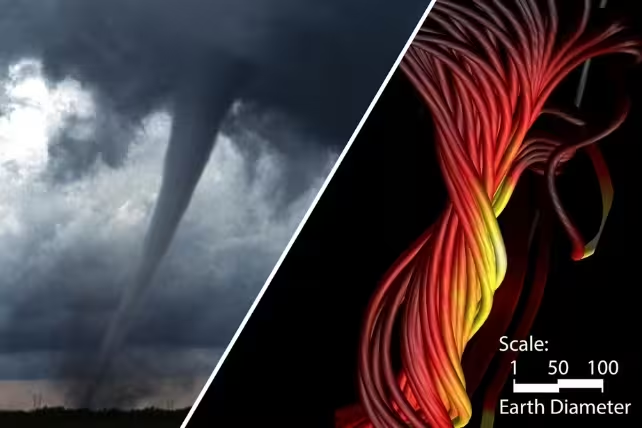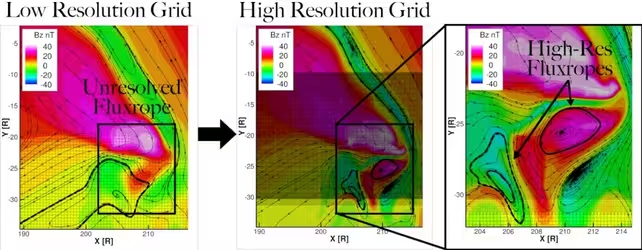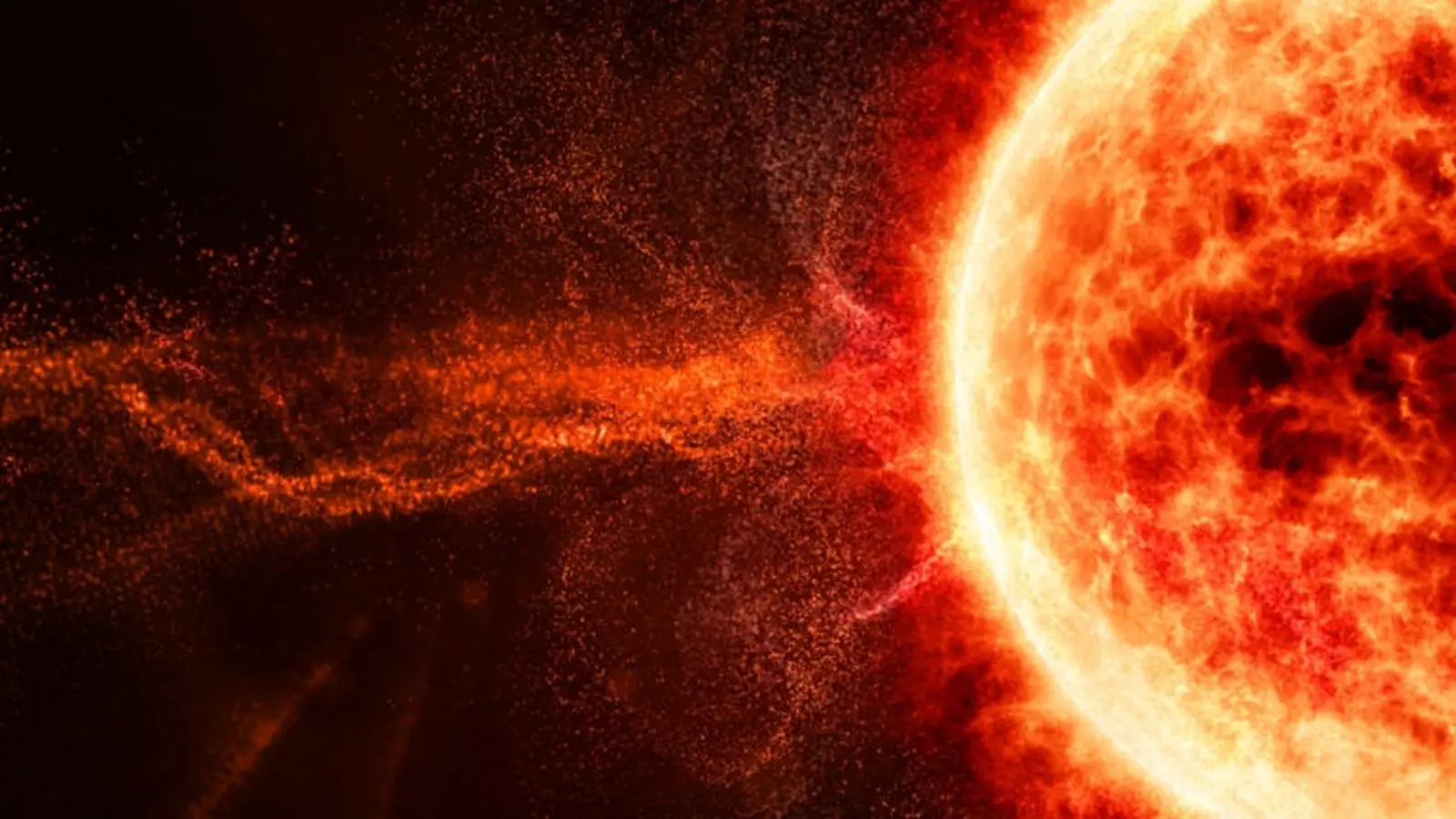11 Minutes
Imagine a storm in space the size of the Sun’s influence, spawning dozens of smaller, tornado-like vortexes that race toward Earth. New high-resolution simulations show that these compact magnetic structures—called flux ropes—can form between the Sun and our planet and carry enough power to spark damaging geomagnetic storms. This discovery reshapes how scientists think about space weather and highlights gaps in our current monitoring and forecasting systems.
From solar eruptions to unexpected geomagnetic storms
Space weather is not a poetic metaphor — it’s a scientific reality with real-world consequences. The Sun frequently ejects charged plasma and twisted magnetic fields. The most dramatic of these eruptions, coronal mass ejections (CMEs), can travel through the solar system at thousands of kilometers per second. When a CME collides with Earth’s magnetic field, it can trigger geomagnetic storms that light up polar skies with auroras and, in severe cases, disrupt power grids, satellite electronics and radio communications.
But observations over recent years hinted at a puzzle: geomagnetic storms sometimes appear without a clear CME impact traced back to the Sun. What else might be traveling through the solar wind that can agitate Earth’s magnetic environment? That question motivated a research effort to look for smaller-scale drivers of space weather — events that would be too compact to register clearly in routine global models or in single-satellite datasets.
What are flux ropes, and why they matter
Flux ropes are bundles of magnetic field lines wrapped around one another like strands of rope. In space physics they often appear inside CMEs, but they also can form independently in the solar wind under the right conditions. Observations from satellites had previously detected small flux ropes, but it was unclear where they originated: did they emerge from the Sun, or could they form locally as the solar wind interacted with larger eruptions?

Flux ropes (simulated, right) are structures made up of magnetic field lines wrapping around each other like a rope, which look similar to tornadoes on Earth. (NOAA, Mojtaba Akhavan-Tafti and Chip Manchester)
Understanding these structures matters because a sufficiently strong and well-oriented flux rope can induce electric currents when it encounters Earth’s magnetosphere. Those currents can stress power transformers and induce voltage fluctuations across large regions—a key mechanism behind widespread power outages during extreme space weather.
Why current space-weather models were missing the small stuff
Forecasting space weather is computationally demanding. To capture a CME traveling from the Sun to Earth, modelers use a simulation box that spans hundreds of millions of kilometers. To make the calculations tractable, those global models treat plasma and magnetic fields like a fluid and divide space into relatively large cubic cells. Each cube might represent a region roughly one million miles (1.6 million kilometers) on a side — about 1% of the Sun–Earth distance. That coarse grid is excellent for capturing large-scale dynamics but poor at resolving compact, fast-evolving features.
Think of it like weather maps: a global forecast that shows only continental-scale winds won’t reveal a hurricane. In the same way, a global heliospheric simulation may miss compact flux ropes because they occupy only a tiny fraction of the simulation volume and evolve on smaller spatial scales than the grid can represent.
The research team began its search by re-examining earlier global simulations. The challenge was like hunting for a needle in a haystack — looking for a transient, localized blip within an area hundreds of times wider than the Sun. At first, nothing obvious appeared. Then the team focused on the modeled solar eruption from May 2024, inspecting the region where a CME slammed into the slower-moving solar wind ahead of it. There, they found hints: small magnetic islands consistent with flux ropes. But in the coarse model, those features were ephemeral; they fizzled out simply because the simulation grid could not resolve them.
Improved resolution along the right path: the breakthrough
Rather than doubling resolution everywhere (an unaffordable proposition computationally), researchers adopted a targeted approach. They kept the global context but refined the grid only along the predicted path of the evolving structures. In effect, they embedded finer cubes along a narrow wedge from the Sun toward Earth — increasing spatial resolution by nearly two orders of magnitude in the most relevant region.
The results were immediate and revealing. The high-resolution window showed that when a fast CME plowed into slower solar wind ahead of it, the collision triggered a complex cascade of instabilities. Those instabilities rolled up into a constellation of flux ropes—magnetic vortices that formed rapidly and then propagated sunward and anti-sunward within the solar wind.

A comparison of low and enhanced simulation grid sizes. We identified one flux rope in the original, low-resolution simulation, but it soon fizzled out. When we improved the simulation grid, we could see multiple flux ropes. (CC BY-NC-ND)
In meteorological terms, this process resembles a hurricane spawning multiple tornadoes in its wake. The simulated flux ropes were not just transient curiosities. They persisted longer than expected, maintained strong magnetic fields, and in some configurations could drive significant geomagnetic activity when directed at Earth.
How these simulated 'tornadoes' form and travel
The refined simulations traced the genesis of flux ropes to the shock and shear layer that forms where a fast eruption overtakes the upstream solar wind. That interaction creates regions of compressed magnetic field and strong velocity shear. Under those conditions, magnetic field lines can reconnect and roll up into small-scale helical structures — flux ropes. Once formed, these islands of twisted magnetic flux travel outward embedded in the flow of interplanetary plasma.
This two-dimensional cut of the simulation box shows a solar eruption that moves toward Earth quickly. The eruption slams into the slower solar wind ahead of it, causing the formation of a constellation of magnetic flux ropes.
The magnetic flux ropes appear as islands in the simulation box. The solid lines represent magnetic field lines, and the color bar shows the number of charged particles. Flux ropes move toward Earth upon formation in the solar wind.
The video also shows how the Space Weather Investigation Frontier space mission, or SWIFT, a constellation of four satellites forming a tetrahedron configuration, could examine the formation and growth of these structures in the solar wind.
Watching these flux ropes in the simulation form so quickly and move toward Earth was exciting, but concerning. It was exciting because this discovery could help us better plan for future extreme space weather events. It was at the same time concerning because these flux ropes would only appear as a small blip in today's space weather monitors.
Implications for forecasting and infrastructure
The discovery that flux ropes can form locally in the solar wind has several practical implications:
- Forecast complexity: Models that only represent large-scale CMEs may underestimate the frequency and intensity of geomagnetic disturbances because they miss compact flux ropes that can nonetheless drive strong currents in Earth's magnetosphere.
- Observational gaps: Single satellites or widely separated monitors can easily miss these small, fast structures. Detecting and characterizing flux ropes requires multi-point measurements with sufficient spatial and temporal resolution.
- Infrastructure risk: Even compact flux ropes can create strong magnetic field changes at Earth if their orientation strongly couples with our magnetosphere. That can produce localized but disruptive impacts to power grids, pipelines and satellite systems.
Because flux ropes may appear as small signals in current space-weather monitors, predicting their arrival, orientation and impact will require both better models and new observations. The good news is that mission concepts and instrument technologies are now advancing to meet this challenge. Constellations of small satellites, like the Space Weather Investigation Frontier (SWIFT) concept, could sample the solar wind in three dimensions and provide the temporal coverage needed to catch flux-rope formation in action.
Expert Insight
“This work highlights a blind spot in traditional space-weather forecasting,” says Dr. Elena Torres, a heliophysicist at the Space Weather Research Center (fictional). “Global models have been indispensable for predicting major CME impacts, but their coarse grids mask smaller structures that can still produce serious geomagnetic effects. By combining targeted high-resolution modeling with multi-satellite observations, we can begin to close that gap and provide more reliable alerts for critical infrastructure.”
Her comment echoes a broader view in the community: forecasting improvements must be multidisciplinary, combining advanced numerical methods, efficient use of computational resources, and the deployment of new observing platforms.
Technologies and missions that can help
Several technical paths can improve our ability to detect and forecast flux-rope-driven disturbances:
High-resolution, hybrid modeling
Adaptive mesh refinement and nested-grid approaches let simulations allocate finer resolution to regions of interest, as the recent study demonstrates. Hybrid models that blend fluid (magnetohydrodynamic) descriptions with particle kinetics in key regions could capture small-scale reconnection and instability physics that form flux ropes.
Distributed satellite constellations
Single-point measurements give limited context. Tetrahedral and string-of-pearls satellite formations can measure three-dimensional structure and temporal evolution. Missions like the proposed SWIFT constellation would be ideal for resolving the birth and propagation of flux ropes in the solar wind.
Improved ground-based and space-based infrastructure monitoring
On Earth, a denser network of magnetometers and better transformer monitoring can detect localized geomagnetic disturbances sooner. In space, resilient satellite electronics, redundant systems, and rapid-response operational procedures will reduce vulnerability to unpredicted small-scale events.
What comes next for researchers and society?
Researchers will extend the new high-resolution approach to a wider set of solar eruptions and solar-wind conditions to map how frequently flux ropes are generated and what determines their size, magnetic strength and lifespan. The next steps include coupling these refined models to downstream magnetospheric simulations to quantify the real risk to power grids and satellites for a broader range of scenarios.
For policymakers and critical infrastructure operators, the takeaway is that space weather risk is multi-scale. Large CMEs deserve attention, but smaller, locally formed flux ropes add another layer of hazard that can arrive with little notice. Strengthening space-weather monitoring with targeted satellite constellations and integrating high-resolution modeling into operational forecasts are key actions that can reduce surprises.
Ultimately, the discovery of locally formed solar 'tornadoes' in the solar wind reshapes our risk landscape. It’s a reminder that the Sun–Earth connection is dynamic across scales, and that preparing for space weather requires tools that can see both the storms and the tornadoes they spawn.
Source: sciencealert
Comments
skyspin
Feels a bit overhyped? cool tech but unless we deploy more satellites, predictions still gonna miss these tiny vortices. money, priorities.
Marius
is this simulation validated by actual satellite data? single runs can show weird artifacts, so curious how robust this is...
atomwave
whoa, space tornadoes? didn't expect tiny flux ropes could hit us so hard. kinda scary, also fascinating. if true, yikes for grids


Leave a Comment